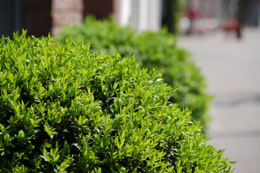Boxwood is very popular, when it comes to landscaping. This write-up provides instructions that must be followed while caring for this shrub.

Boxwood or
Buxus is a genus of 70 species that have been used for landscaping for ages. Due to their growth pattern and dense foliage, these shrubs can also be used for foundation planting. These can be grown alone or with other plants to beautify any area. They are also used by the landscapers to enclose certain areas or separate one space from other.
Planting them will definitely impact the landscaping in a positive manner. The tiny foliage along with the dense texture provides the landscapers with an excellent opportunity to shape these shrubs into beautiful shapes and patterns. These are generally used to make hedges and garden borders. These can also be used for the purpose of outlining a walkway, border, or terrace.
Types
English boxwood is one of the most popular variety. This accent plant can grow up to a height of 3 feet. Due to their slow growing nature, it is an ideal landscaping plant. It usually grows at the rate of an inch per year. It blooms during the spring season. Another common variety is American boxwood. Though American boxwood produces small green flowers, these are hardly noticeable. This variety is known for its glossy leaves. This plant can grow up to 10 feet in height. Some of the other varieties are Green Tower, Green Velvet, Variegata, Green Mountain, and Dwarf English boxwood.
Conditions Required for Growth
Planting
The perfect time to plant these shrubs would be the spring or fall. Though these shrubs can grow in full sun, they prefer partial shade. So, select a site that fulfills this requirement. To plant these shrubs, you must first dig planting holes. Dig a hole which is as deep as the root ball. Now, take the shrub out of the container and place it in the hole. Add soil to the planting hole. Water the plant thoroughly. The soil should be well-drained. You should also test the soil for pH levels. The soil with pH between 6.5-7.5 is suitable for the growth of these shrubs. If you are planting many shrubs, make sure that you keep a distance of 12-18 inches between two shrubs.
Watering
You need to water frequently in the growing phase. Also, pay attention during the dry spells and during the late fall. Keep the soil moist, but don't go on a watering spree. These shrubs have a shallow root system, and watering them very frequently can damage the roots. Phytophthora root rot is a disease that is mainly caused due to excess watering.
Mulching
Besides adding compost, peat moss, or manure to replenish the soil, you must also add a layer of mulch. This will help in retaining the soil moisture and keeping the soil cool. It would be advisable to add about 3-4 inches of mulch during the summer season. Mulching must also be done during the winter season. You could use chopped leaves for mulching, but make sure that these are not placed very close to the stem.
Pruning
You must remove all dead and diseased branches. Pruning must also be done to give shape to the shrubs. Pruning will promote better growth, but it should not be very severe. You should prune outer branches slightly to allow light to enter deeper into the plant. Remove the dead twigs, because if allowed to stay at the center of the shrubs, these can lead to growth of fungus and damage the plant.
If you are planning to plant this topiary plant in your garden, follow the aforementioned instructions to keep it in a good condition.






 Boxwood or Buxus is a genus of 70 species that have been used for landscaping for ages. Due to their growth pattern and dense foliage, these shrubs can also be used for foundation planting. These can be grown alone or with other plants to beautify any area. They are also used by the landscapers to enclose certain areas or separate one space from other.
Boxwood or Buxus is a genus of 70 species that have been used for landscaping for ages. Due to their growth pattern and dense foliage, these shrubs can also be used for foundation planting. These can be grown alone or with other plants to beautify any area. They are also used by the landscapers to enclose certain areas or separate one space from other.